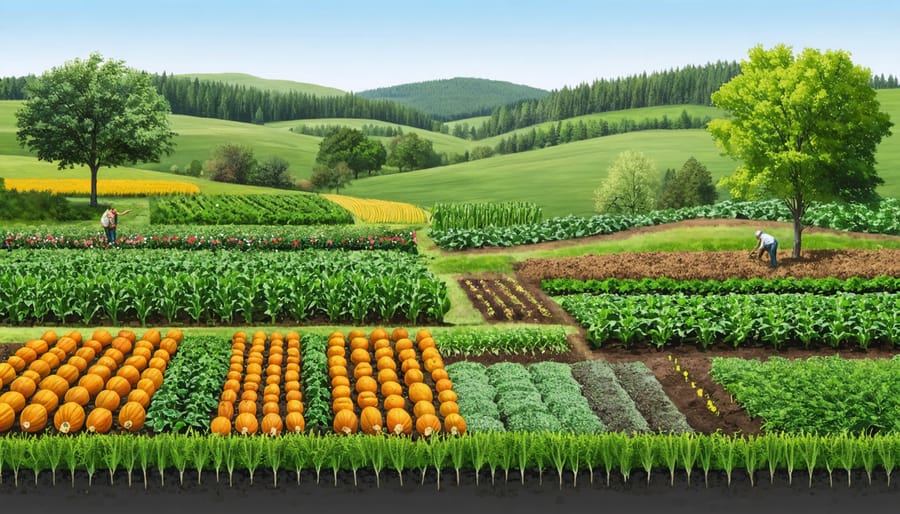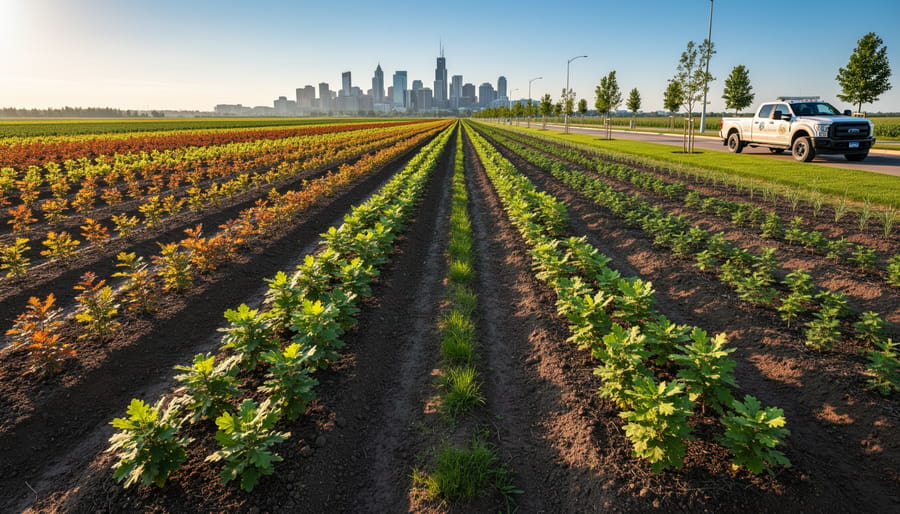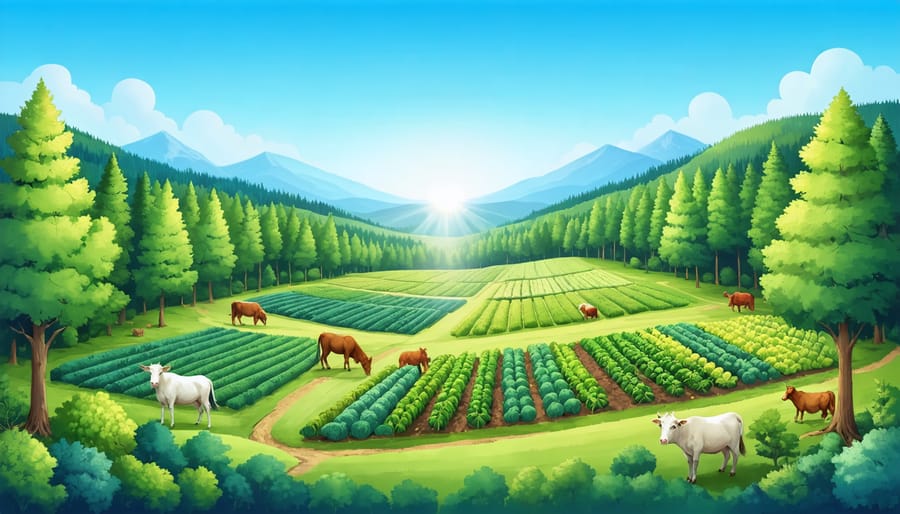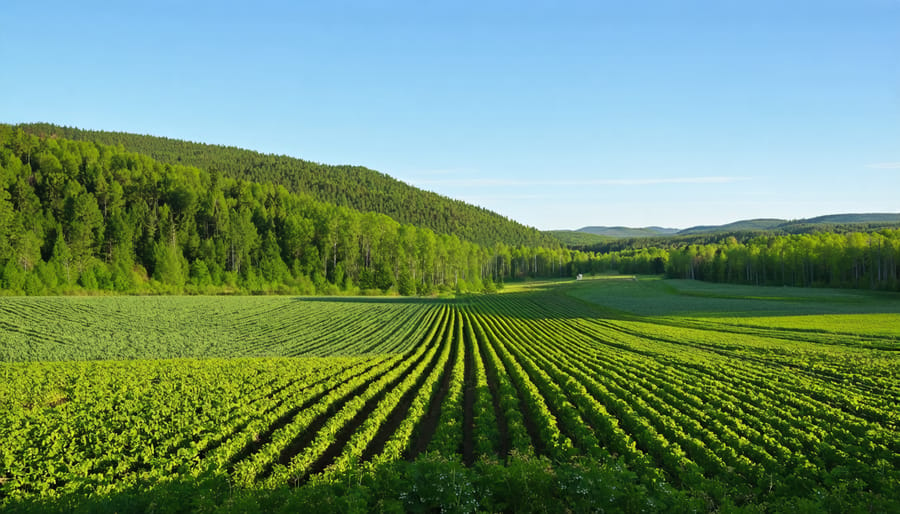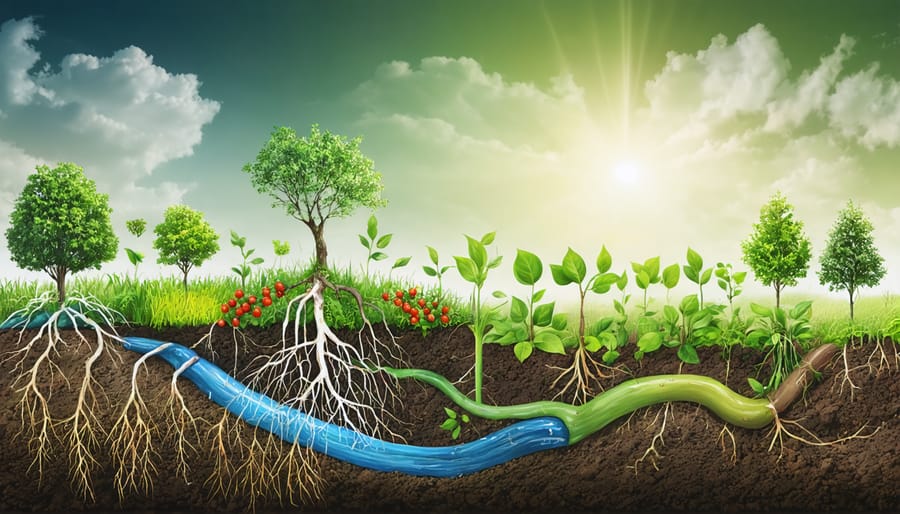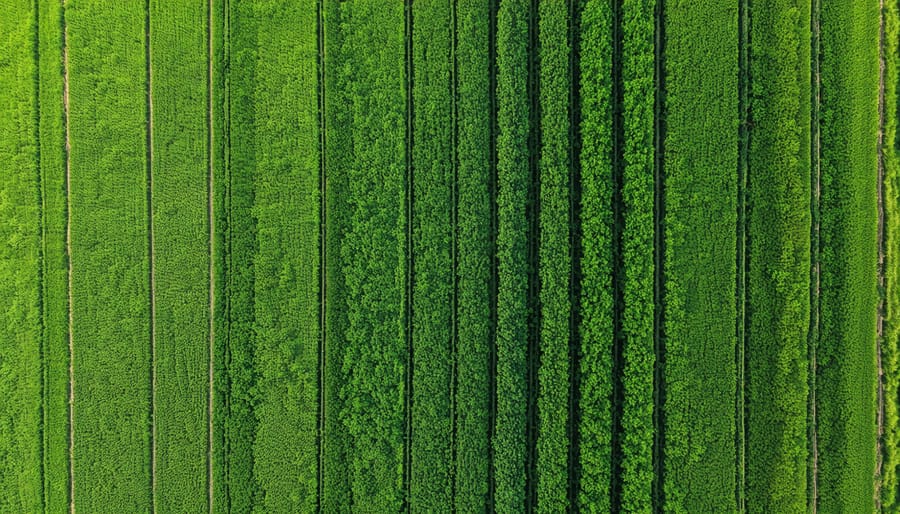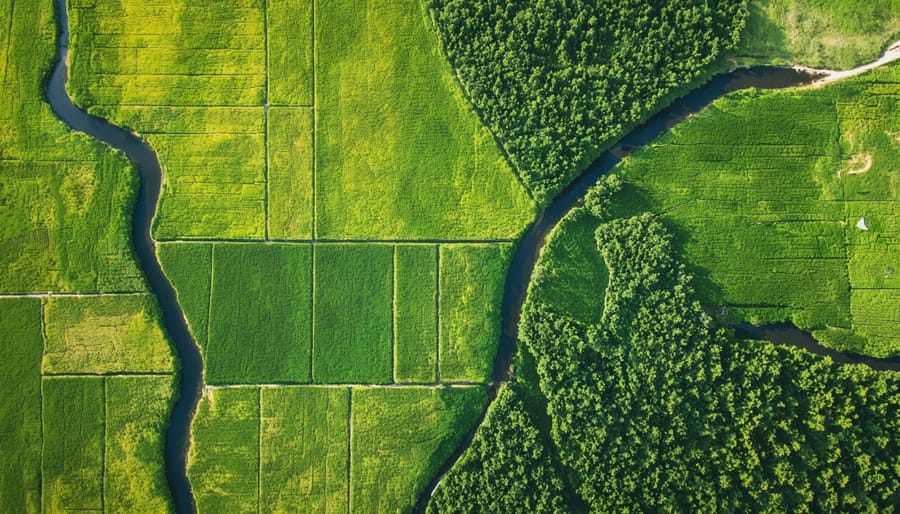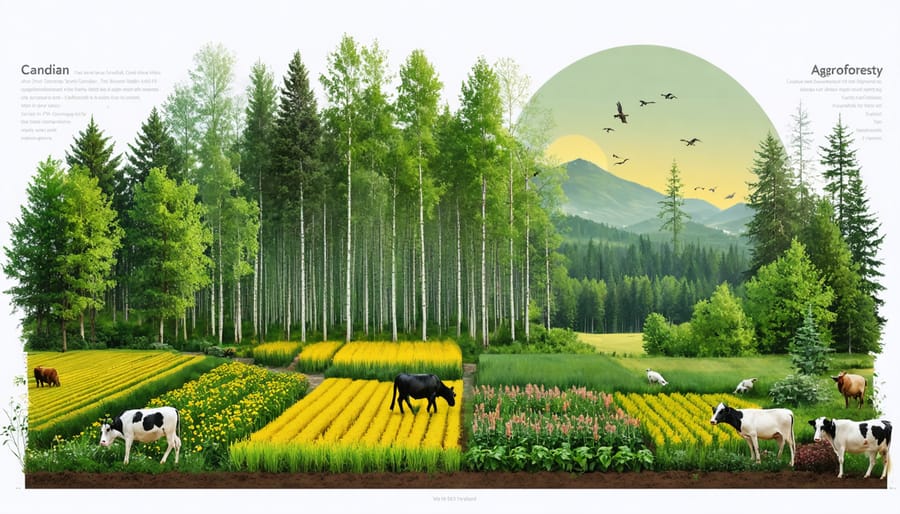Indigenous agroforestry stands as one of North America’s most sophisticated and sustainable food production systems, developed over thousands of years by First Nations communities across what is now Alberta and beyond. By integrating trees, crops, and traditional ecological knowledge, these time-tested methods produced abundant harvests while maintaining healthy ecosystems. Today, as Alberta farmers face mounting challenges from climate change and soil degradation, these ancient techniques offer proven solutions for modern agriculture.
From the Three Sisters companion planting of corn, beans, and squash to the strategic use of shelter belts and food forests, indigenous agroforestry demonstrates how working with nature—rather than against it—creates resilient agricultural systems. These methods have particular relevance for Alberta’s diverse growing regions, where traditional knowledge can help farmers adapt to changing conditions while improving soil health and biodiversity.
Leading agricultural scientists and indigenous knowledge keepers are now collaborating to blend these time-honored practices with contemporary farming techniques, creating hybrid systems that honor traditional wisdom while meeting modern production needs. For Alberta’s farming community, this represents an opportunity to embrace sustainable practices deeply rooted in the land’s history.
Indigenous Agroforestry: A Time-Tested System
Traditional Forest Gardens
Traditional forest gardens represent one of the most sophisticated forms of Indigenous land management, combining food production with ecosystem preservation. These carefully designed spaces featured multiple layers of vegetation, from towering nut trees to understory fruit bushes and ground-cover plants, creating a self-sustaining food system that mimicked natural forest structures.
Indigenous peoples across Canada maintained these gardens through selective harvesting, controlled burning, and strategic planting. They would cultivate food-bearing plants alongside medicinal herbs and other useful species, creating diverse landscapes that provided year-round sustenance. For example, in British Columbia’s coastal regions, Indigenous communities managed extensive gardens that included crabapple trees, berry bushes, and patches of edible roots.
These forest gardens weren’t just food sources – they were living seed banks that preserved genetic diversity and enhanced soil fertility naturally. Through careful observation and generational knowledge, Indigenous gardeners understood how different plants supported each other’s growth, practicing companion planting long before it became a modern agricultural concept.
Today, these traditional methods offer valuable insights for sustainable agriculture. The principles of forest gardening demonstrate how we can create productive agricultural systems that work with nature rather than against it, providing lessons in biodiversity, soil health, and sustainable resource management.
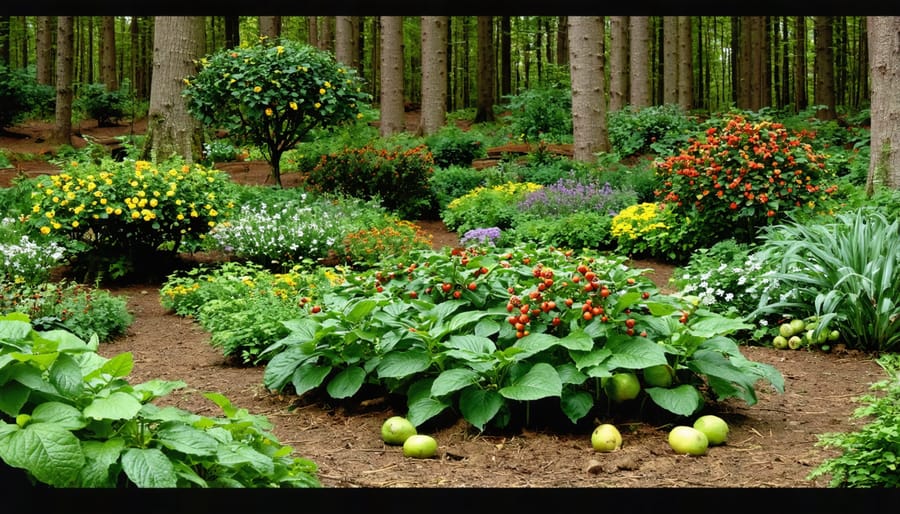
Sacred Relationships with the Land
Indigenous peoples across Canada have long maintained a deep, spiritual connection with the land that goes far beyond mere resource management. This relationship forms the foundation of traditional agroforestry practices, where the land is viewed not as a commodity, but as a living entity deserving of respect and reciprocal care.
In Alberta, Traditional Knowledge Keepers teach that every tree, plant, and natural feature has its own spirit and purpose. This worldview has shaped sustainable land management practices for thousands of years, emphasizing the importance of taking only what is needed and ensuring resources remain available for future generations.
Traditional ecological knowledge includes understanding the interconnectedness of all living things, from the soil microorganisms to the tallest trees. This holistic approach has proven remarkably effective in maintaining biodiversity and ecosystem health while producing food and other resources sustainably.
Many Indigenous communities practice the principle of “Seven Generations” thinking, where land management decisions are made by considering their impact on descendants seven generations into the future. This long-term perspective encourages careful stewardship and sustainable harvest practices that maintain the health of forest ecosystems while supporting community needs.
Modern Applications in Alberta
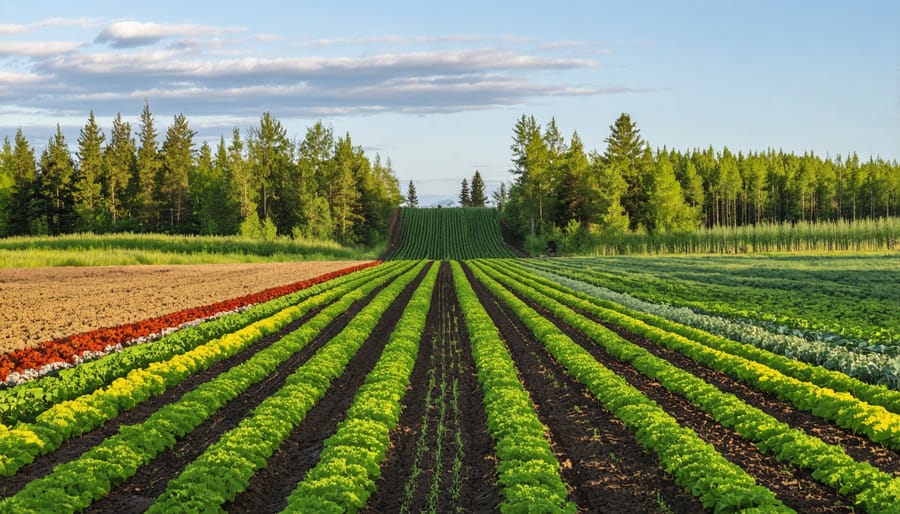
Successful Case Studies
Among the many success stories across Canada, Alberta farmers have shown remarkable achievements in implementing indigenous agroforestry methods. The Running Horse Farm near Cardston has successfully integrated traditional Blackfoot three-sisters planting techniques with modern farming practices. Owner Sarah Thompson reports a 30% increase in soil fertility and a significant reduction in water usage since adopting these methods five years ago.
In the Peace River region, the Mitchell family farm has embraced indigenous windbreak systems, incorporating native species like saskatoon berries and chokecherries. This approach has not only provided additional income streams through berry harvesting but has also improved crop yields in adjacent fields by 20% due to enhanced wind protection and soil moisture retention.
The Red Deer River Valley showcases another success story with the Cooper Heritage Farm. Working closely with local Indigenous elders, the Coopers have implemented traditional companion planting methods and established food forests using native species. Their innovative approach includes rotating livestock through woodlots, a practice inspired by Indigenous land management techniques. The farm now serves as an educational hub, hosting workshops for other farmers interested in indigenous agroforestry methods.
Near Edmonton, the Prairie Roots Collective has created a collaborative farming project that combines modern organic certification requirements with traditional Indigenous knowledge. Their system of integrating medicinal plants with market crops has created new revenue streams while preserving traditional plant knowledge. The collective’s approach has proven particularly resilient during drought years, maintaining productivity while conventional farms in the area struggled.
These examples demonstrate how indigenous agroforestry methods can be successfully adapted to modern farming operations while honoring traditional knowledge and improving farm sustainability.
Environmental Benefits
Indigenous agroforestry systems offer remarkable environmental benefits that are increasingly relevant to modern agricultural challenges. By integrating trees and shrubs with crops and livestock, these traditional practices are proving to be effective climate-resilient farming practices that protect and enhance our natural resources.
One of the most significant advantages is the system’s success in improving soil health. The deep root systems of trees and perennial plants help prevent erosion, increase organic matter content, and enhance soil structure. In Alberta’s prairie regions, where wind erosion can be a significant concern, these techniques have shown remarkable success in stabilizing topsoil and building fertility naturally.
Biodiversity thrives in indigenous agroforestry systems. The varied vegetation creates multiple habitats for beneficial insects, birds, and other wildlife. Many Alberta farmers have reported increased populations of pollinators and natural pest predators after implementing these methods, reducing the need for chemical interventions.
The climate benefits are equally impressive. Trees and woody plants in agroforestry systems sequester significant amounts of carbon both above and below ground. They also create beneficial microclimates that protect crops and livestock from extreme weather events, which are becoming more frequent across the prairies. The enhanced water retention capacity of these systems helps farms remain productive during drought periods while reducing flood risks during heavy rainfall.
Indigenous agroforestry practices also support water quality by acting as natural filters. The root systems help prevent nutrient runoff, protecting local waterways and maintaining clean water resources for surrounding communities. This is particularly valuable in watershed areas where agricultural impacts on water quality are a growing concern.
These environmental benefits create a positive feedback loop: healthier ecosystems support more productive farms, which in turn can maintain these beneficial practices for generations to come.
Implementation Strategies
Getting Started
Starting your journey into indigenous agroforestry begins with careful planning and community engagement. Before implementing any changes to your land, take time to research and connect with local Indigenous knowledge keepers and agricultural experts who can provide valuable insights into traditional practices suited to your specific region.
Begin by conducting a thorough assessment of your land, noting existing tree species, soil conditions, and water resources. This baseline information will help you develop a plan that honors both traditional knowledge and your farm’s unique characteristics. Consider reaching out to your local agricultural extension office or indigenous agricultural organizations for guidance on understanding implementation challenges specific to Alberta’s climate and growing conditions.
Start small with a pilot project of 1-2 hectares, incorporating these key steps:
1. Select native tree and shrub species traditionally used in your region
2. Design your planting layout based on traditional spacing patterns
3. Prepare the soil using minimal-disturbance techniques
4. Establish windbreaks and shelter belts using indigenous species
5. Integrate companion planting principles based on traditional knowledge
Consider incorporating traditional Three Sisters growing methods – planting corn, beans, and squash together – between tree rows. This proven Indigenous practice maximizes space utilization while maintaining soil health. For Alberta farmers, saskatoon berries, chokecherries, and hazelnuts are excellent native species to start with.
Document your progress and share experiences with other farmers in your community. Many successful indigenous agroforestry projects in Alberta began as small initiatives that grew through knowledge sharing and community support. Remember that this is a long-term investment in your land’s future, requiring patience and adaptive management as your system develops.
Join local farming networks and attend workshops focused on indigenous agricultural practices. These connections will provide ongoing support and help you adapt traditional methods to modern farming challenges while respecting indigenous knowledge and principles.
Community Partnerships
Building meaningful partnerships with Indigenous communities is fundamental to the success of agroforestry initiatives in Canada. These relationships must be founded on mutual respect, trust, and genuine collaboration rather than merely extracting traditional knowledge.
The Beaver First Nation in northern Alberta offers an exemplary model of community partnership. Their collaborative project with local farmers has created a knowledge-sharing network where traditional methods of forest management are integrated with modern agricultural practices. This partnership has led to the successful implementation of silvopasture systems that benefit both Indigenous and non-Indigenous farmers while preserving traditional land management techniques.
Key elements for establishing successful partnerships include:
– Approaching Indigenous knowledge holders with respect and openness to learn
– Recognizing Indigenous communities as equal partners in project development
– Ensuring fair compensation for shared knowledge and expertise
– Maintaining long-term commitments beyond initial consultations
– Supporting Indigenous-led initiatives and decision-making processes
The Alberta Indigenous Gardening Project demonstrates these principles in action. This initiative brings together elders, young Indigenous community members, and local farmers to share knowledge about native plant species, traditional growing methods, and sustainable land management practices.
To begin building these relationships, farmers can:
– Reach out to local Indigenous organizations and friendship centres
– Attend community events and workshops when invited
– Participate in Indigenous-led agricultural initiatives
– Support Indigenous food sovereignty programs
– Share resources and equipment when appropriate
Remember that successful partnerships develop over time and require patience, understanding, and genuine commitment to mutual benefit. Many Indigenous communities have established protocols for knowledge sharing and collaboration – respecting these processes is essential for building trust and maintaining positive relationships.
The rewards of these partnerships extend beyond agricultural benefits, fostering reconciliation and creating stronger, more resilient local food systems that honor both traditional and contemporary farming practices.
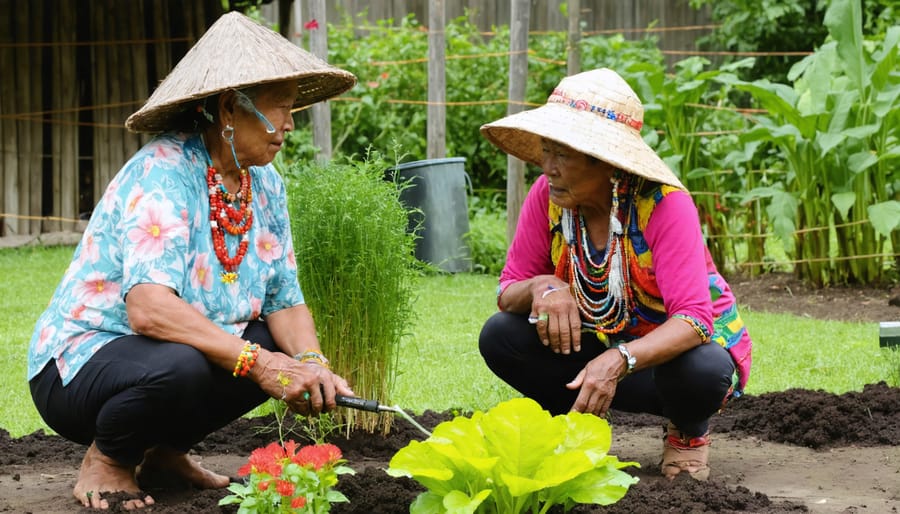
Indigenous agroforestry practices offer a wealth of knowledge and proven techniques that can significantly enhance modern farming operations across Alberta and beyond. By integrating these time-tested methods with contemporary agricultural approaches, we can create more resilient, productive, and sustainable farming systems that benefit both the environment and our communities.
Throughout this exploration of indigenous agroforestry, we’ve seen how traditional practices like companion planting, strategic tree integration, and natural pest management have stood the test of time. These methods not only improve soil health and biodiversity but also contribute to climate change resilience and increased crop yields. The success stories from farms across Alberta demonstrate that these practices can be effectively adapted to modern agricultural operations of any size.
As we look to the future of farming in Canada, indigenous agroforestry presents an opportunity to reconnect with the land while building more sustainable food systems. The integration of trees and crops, careful water management, and holistic approach to ecosystem health align perfectly with current sustainability goals and environmental stewardship initiatives.
We encourage Alberta farmers to take the first steps toward incorporating indigenous agroforestry practices into their operations. Start small, perhaps with a pilot project on a portion of your land, and gradually expand as you see the benefits unfold. Connect with local indigenous communities, agricultural extension services, and fellow farmers who have successfully implemented these methods.
Remember, adopting indigenous agroforestry practices isn’t just about improving farm productivity – it’s about being part of a larger movement toward sustainable agriculture and honoring the traditional knowledge that has sustained these lands for generations. Together, we can build a more resilient and sustainable agricultural future for Alberta.

